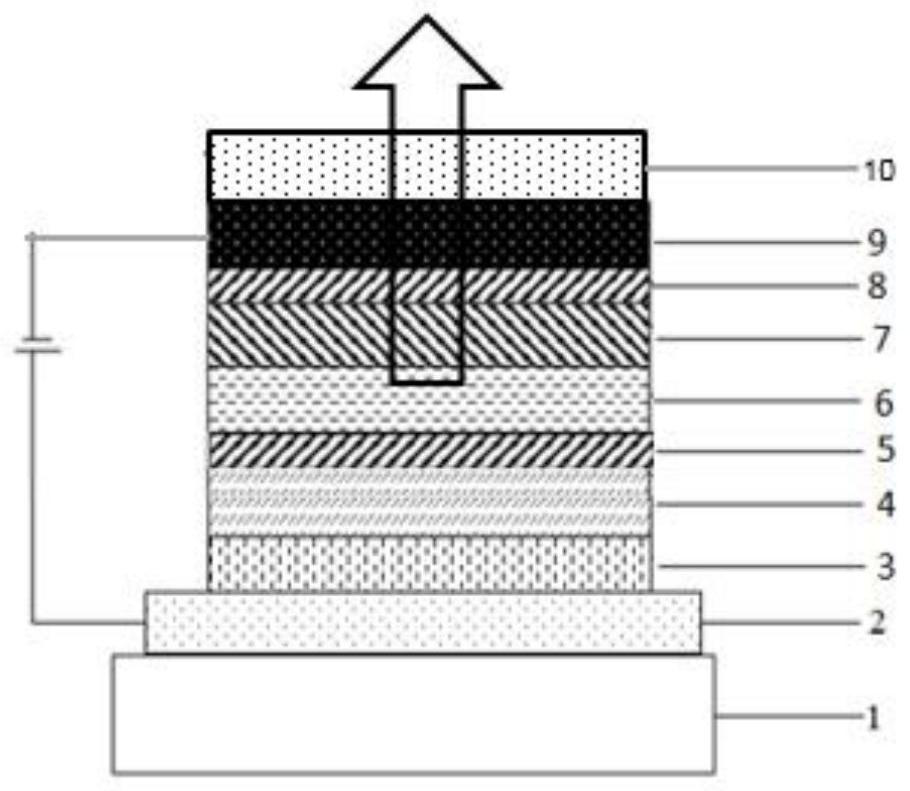Organic compound taking carbazole as core and organic electroluminescent device containing organic compound
An organic compound, carbazole technology, applied in the field of organic electroluminescent devices, can solve the problems of large drop in light extraction efficiency, high material evaporation temperature, low refractive index, etc., achieve high Tg and molecular thermal stability, excellent The effect of overall performance
- Summary
- Abstract
- Description
- Claims
- Application Information
AI Technical Summary
Problems solved by technology
Method used
Image
Examples
preparation example Construction
[0062] Preparation of Intermediate A:
[0063] Take the preparation methods of intermediate A-2 and intermediate A-3 as an example.
[0064]
[0065] In a 250ml three-neck flask, under the protection of nitrogen, add 0.012mol raw material C-2, 0.01mol raw material D-2, 150ml toluene and stir to mix, then add 5×10 -5 mol Pd 2 (dba) 3 , 5×10 -5 mol P(t-Bu) 3 , 0.03mol sodium tert-butoxide, heated to 110°C, refluxed for 22 hours, sampling plate, showed no bromide remaining, the reaction was complete; naturally cooled to room temperature, filtered, the filtrate was rotary evaporated to no fraction, passed through a neutral silica gel column , to obtain intermediate A-2;
[0066] Elemental analysis structure (molecular formula C 30 h 17 Br 2 NO): Theoretical value: C, 63.52; H, 3.02; N, 2.47; Test value: C, 63.54; H, 3.03; N, 2.45; The measured value is 567.05.
[0067]
[0068] In a 250ml three-neck flask, under the protection of nitrogen, add 0.012mol raw material...
Embodiment 1
[0078] Embodiment 1: the synthesis of compound 9
[0079]
[0080] In a 250mL three-necked flask, nitrogen gas was introduced, 0.02mol of intermediate A-1, 150ml of DMF, 0.05mol of intermediate B-1, 0.0005mol of palladium acetate were added, stirred, and then 6mL of 0.01mol / mLK 3 PO 4 The aqueous solution was heated to reflux at 150°C for 24 hours, and the sample was spotted on a plate, and the reaction was complete. After natural cooling, 150 mL of water was added, the mixture was filtered and the filter cake was dried in a vacuum oven, and the obtained residue was purified by a silica gel column to obtain compound 9;
[0081] Elemental analysis structure (molecular formula C 49 h 28 N 2 o 3 ): theoretical value C, 84.95; H, 4.07; N, 4.04; test value C, 84.26; H, 4.11; N, 4.09. ESI-MS(m / z)(M + ): The theoretical value is 692.21, and the measured value is 692.17.
Embodiment 2
[0082] Embodiment 2: the synthesis of compound 21
[0083]
[0084] The preparation method of compound 21 is the same as that of Example 1, except that intermediate A-1 is replaced by intermediate A-2, and intermediate B-1 is replaced by intermediate B-2.
[0085] Elemental analysis structure (molecular formula C 56 h 33 N 3 o 3): theoretical value C, 84.51; H, 4.18; N, 5.28; test value C, 84.53; H, 4.19; N, 5.28. ESI-MS(m / z)(M + ): The theoretical value is 795.25, and the measured value is 795.29.
PUM
 Login to View More
Login to View More Abstract
Description
Claims
Application Information
 Login to View More
Login to View More - R&D
- Intellectual Property
- Life Sciences
- Materials
- Tech Scout
- Unparalleled Data Quality
- Higher Quality Content
- 60% Fewer Hallucinations
Browse by: Latest US Patents, China's latest patents, Technical Efficacy Thesaurus, Application Domain, Technology Topic, Popular Technical Reports.
© 2025 PatSnap. All rights reserved.Legal|Privacy policy|Modern Slavery Act Transparency Statement|Sitemap|About US| Contact US: help@patsnap.com



